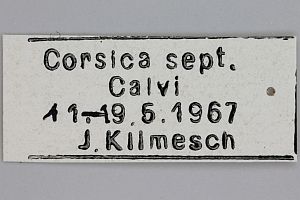2. Diagnose
2.1. Geschlecht nicht bestimmt
2.2. Erstbeschreibung
3. Biologie
3.1. Nahrung der Raupe
- [Plantaginaceae:] Plantago coronopus (Krähenfuß-Wegerich)
Englert (1974: 397) meldete: "Wirtspflanzen: Plantago coronopus (Walsingham, 1900) (Bankes 1901) (Meyrick 1925), (L'Homme 1949). Biologie: Eigene Beobachtungen liegen nicht vor. Die Biologie wird bei Walsingham 1900 und Bankes 1901 beschrieben. Interessant ist, daß M. littorella in einer Pflanze überwintert, deren Blüten im Herbst bald zerfallen. Die Larve beginnt deshalb frühzeitig sich in den Strengel [sic!] einzubohren, in dem sie überwintert."
Walsingham (1900: 127) hatte gemeldet: "The larva feeds on the seeds of Plantago coronopus, where it may be found in the months of September and October, forming a slight gallery between the seeds and stem, and always making an opening communicating with the interior of the stem on which the seeds are fixed, into this it retires with the head upward." Bankes (1901) bestätigt dieses Muster und liefert einige weitere Details; insbesondere konnte er absichern, dass die Verpuppung tatsächlich im Stängel erfolgt.
(Autor: Erwin Rennwald)
4. Weitere Informationen
4.1. Andere Kombinationen
- Gelechia littorella Douglas, 1850 [Originalkombination]
4.2. Synonyme
- Metzneria quinquepunctella Herrich-Schäffer, 1855
4.3. Literatur
- Bankes, E.R. (1901): Notes on Metzneria littorella, Dgl. — The Entomologist's Monthly Magazine. Second Series 12 (= 37): 121-124. [Digitalisat auf biodiversitylibrary.org]
- Erstbeschreibung: Douglas, J. W. (1850): On the British Species of the Genus Gelechia of Zeller. — The Transactions of the Entomological Society of London. New Series 1: 14-21, 60-68.
- Englert, W. D. (1974): Revision der Gattung Metzneria Zeller (Lepid., Gelechiidae) mit Beiträgen zur Biologie der Arten. — Zeitschrift für Angewandte Entomologie 75: 381-421.
- Walsingham (1900): Description of the larva of Metzneria littorella, Dgl. — The Entomologist's Monthly Magazine. Second Series 11 (= 36) (428): 127. [Digitalisat auf biodiversitylibrary.org]




![Vorkommen in Russland (europäischer Teil bis Manytsch-Niederung) [Sinev (2021)]](/res/img/flag/ru.gif)
![Vorkommen in Großbritannien [Agassiz, Beavan & Heckford (2013): Checklist of the Lepidoptera of the British Isles]](/res/img/flag/gb.gif)
![Vorkommen in Frankreich (europäisches Territorium ohne Korsika) [Vandromme et al. (2020): Liste systématique et taxinomique des Lépidoptères de France]](/res/img/flag/fr.gif)

![Vorkommen in Spanien (Festland) [Vives Moreno A. (2014)]](/res/img/flag/es.gif)
![Vorkommen auf den Balearischen Inseln (Spanien) [Vives Moreno A. (2014)]](/res/img/flag/es-ib.gif)
![Vorkommen in Portugal (Festland) [Corley (2018): New and interesting Portugese Lepidoptera 2016]](/res/img/flag/pt.gif)
![Vorkommen in Italien (Festland und kleine festlandsnahe Inseln) [Baldizzone et al. (1995): Checklist delle Specie della Fauna Italiana 83]](/res/img/flag/it.gif)
![Vorkommen in Sizilien [Baldizzone et al. (1995): Checklist delle Specie della Fauna Italiana 83]](/res/img/flag/it-sic.png)
![Einzelnachweis in Kroatien [Karsholt, Baldizzone & Gomboc (2023)]](/res/img/flag/hr.gif)
![Vorkommen auf Zypern [Gozmany (2012): The Lepidoptera of Greece and Cyprus Volume I]](/res/img/flag/cy.gif)
![Vorkommen in Israel [Bidzilya, Karsholt, Kravchenko & Šumpich (2019)]](/res/img/flag/il.gif)




